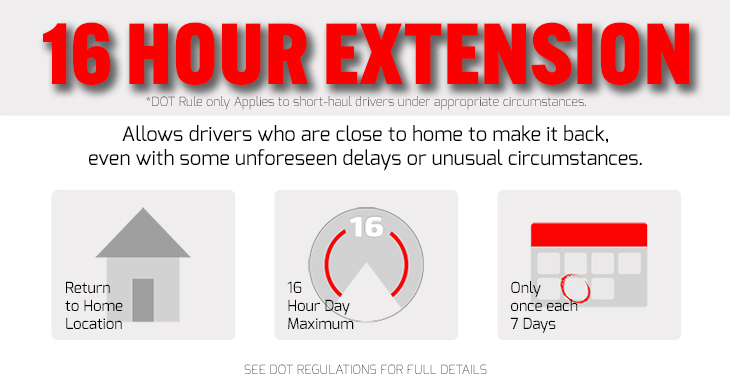by Pride Transport | May 03, 2022
Understanding the DOT 16-Hour Extension Rule for Truck Driving
Safety is of utmost importance for truck drivers as individuals, contributors to their companies, and on a nationwide scale. The trucking industry operates under a strict set of rules and regulations tailored to ensure the safety of commercial drivers and those they share the road with. Key elements include:
- Holding a commercial driver's license (CDL).
- Adhering to more stringent DUI limits.
- Conducting pre- and post-trip vehicle inspections.
- Maintaining an up-to-date physical exam as required by the Department of Transportation.
Moreover, these requirements are subject to frequent updates, making it crucial for drivers to stay informed about the latest standards, particularly the 16-hour extension rule for truck driving in 2022.

What is the DOT 16-hour Rule?
The Federal Motor Carrier Safety Administration (FMCSA) outlines the 16-hour rule in the Interstate Truck Driver’s Guide to Hours of Service, available on their website. This rule forms part of the "hours of service" (HOS) regulations established by the FMCSA to ensure drivers remain alert and safe while on the road. The 16-hour rule is designed to allow drivers who are near their home base to complete their journey, even in the face of unexpected delays or unusual circumstances.
HOS regulations apply to commercial motor vehicle drivers of trucks or truck-tractors with trailers engaged in interstate commerce, meeting any of these criteria:
- Weighing 10,001 pounds (4,536 kg) or more (including any load).
- Having a gross vehicle weight rating or gross combination weight rating of 10,001 pounds (4,536 kg) or more.
- Transporting hazardous materials requiring placards.
Drivers meeting these criteria must strictly adhere to a 14-hour shift limit set by the FMCSA:
"[Drivers] may not drive beyond the 14th consecutive hour after coming on duty, following 10 consecutive hours off duty. Off-duty time does not extend the 14-hour period."
The 16-hour rule, however, offers an exception to this 14-hour limit, primarily catering to short-haul drivers under specific circumstances. If a driver returns to their work-reporting location each day and concludes their workday at home, they may qualify for the 16-hour short-haul exception.
The 16-hour exception permits drivers to extend their 14-hour driving window to 16 hours once every 7 consecutive days, provided they meet specific conditions without compromising safety. It's essential to note that the 16-hour rule does not extend the allowable 11 hours of driving time within the 14- or 16-hour window.
Qualifying for the 16-hour Exemption
To invoke the 16-hour rule and extend their driving window, drivers must meet strict criteria outlined by the FMCSA guide:
- Return to their work reporting location on the same day, as well as for their last 5 duty tours (a duty tour covers the time from reporting to leaving work).
- Be released from duty within 16 hours after starting duty.
- Use this exception once every 7 consecutive days (unless they have taken 34 consecutive hours off to restart a 7- or 8-day period).
- Not qualify for the 'Non-CDL Short Haul Exception.'

Maintaining Records for the 16-Hour Rule
Accurate record-keeping is pivotal in the trucking industry to demonstrate compliance with DOT regulations. Drivers must follow their company's policies for entering a 16-hour exception. Typically, either the driver or fleet manager must record:
- Total driving time over the past week.
- The exact release time for the driver's daily duty completion.
- Daily hours of service (both driving and "on duty").
- Reporting times for each fleet driver.
Several apps are available to help truckers log their hours and classify a 16-hour exception correctly. Some of these apps provide time tracking alerts to facilitate accurate logging and ensure compliance with DOT standards.
Ultimately, the 16-hour rule is a safety measure designed to accommodate unforeseen delays for drivers close to home, without extending the allowable drive time. This regulation aims to safeguard the well-being of drivers while maintaining road safety.
At Pride Transport, we take pride in our safety record and support a culture of safety among our drivers and their teams. Our drivers have achieved remarkable safety milestones, including 500,000 safe miles for 15 Pride drivers, 1,000,000 safe miles for 46 drivers, 2,000,000 safe miles for 13 drivers, and 3,000,000 safe miles for 5 drivers.
Are you wondering what a day in the life of a truck driver is like? Check out this post to see what drivers see and experience on the road. Or if you're interested in learning more of the DOT testing and requirements, check out this one!
If you’re interested in driving yourself, or working to support our fleet of drivers, take a look at our FAQ to see what benefits and culture you’ll find at Pride Transport.
